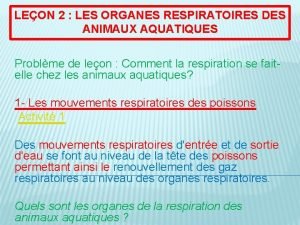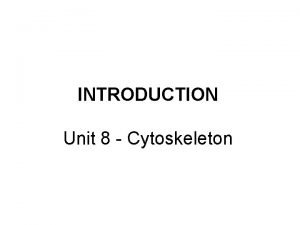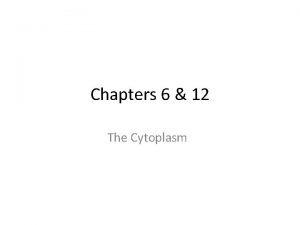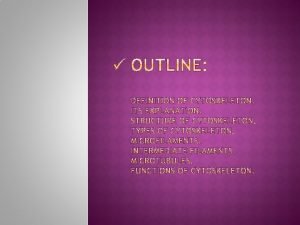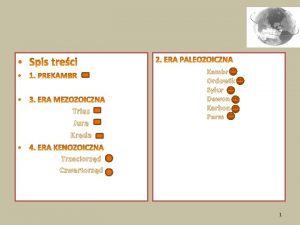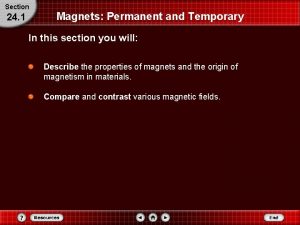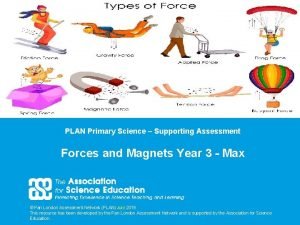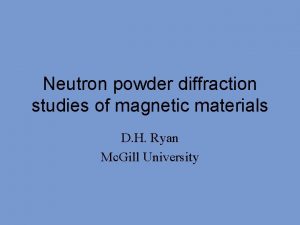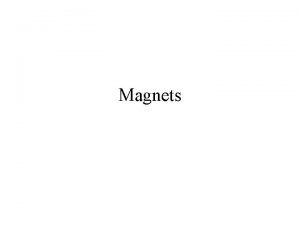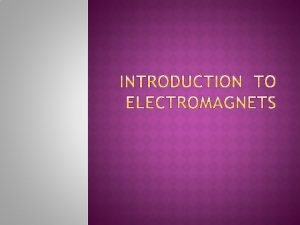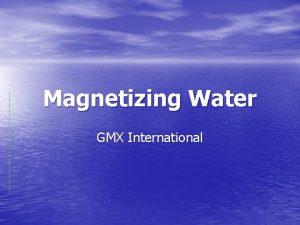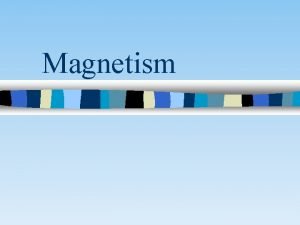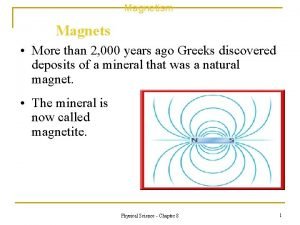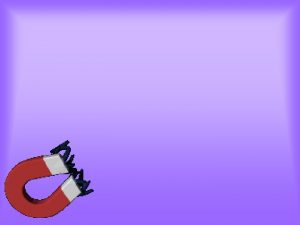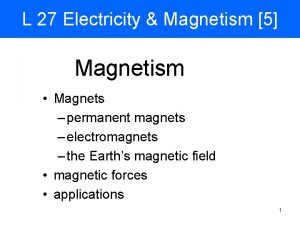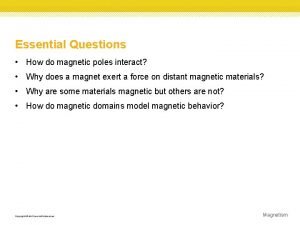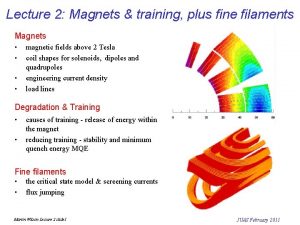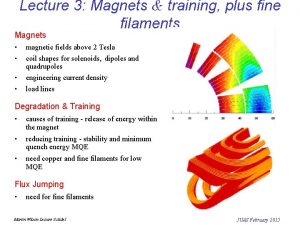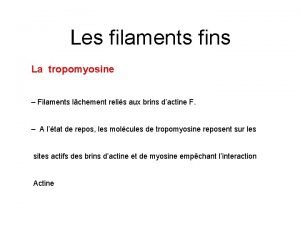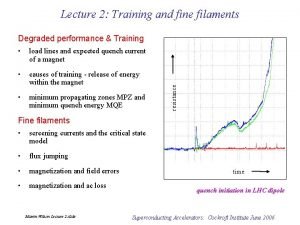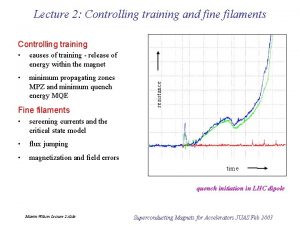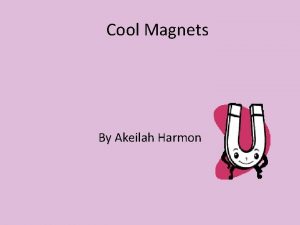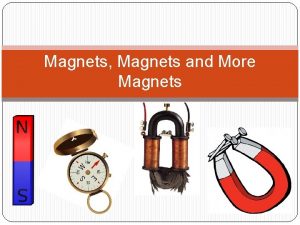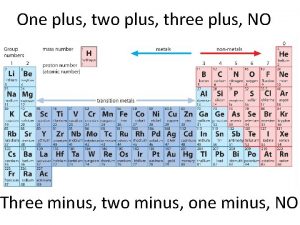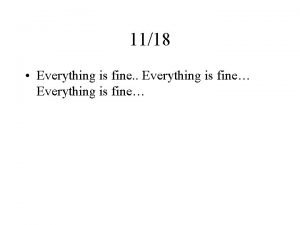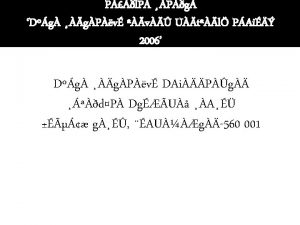Lecture 2 Magnets training plus fine filaments Magnets

































- Slides: 33

Lecture 2: Magnets & training, plus fine filaments Magnets • • the ATLAS magnet at CERN magnetic fields above 2 Tesla coil shapes for solenoids, dipoles and quadrupoles engineering current density load lines Degradation & Training • causes of training - release of energy within the magnet • reducing training - stability and minimum quench energy MQE • need copper and fine filaments for low MQE Flux Jumping • need for fine filaments Martin Wilson Lecture 2 slide 1 JUAS February 2013

Fields and ways to create them: conventional • conventional electromagnets have an iron yoke - reduces magnetic reluctance - reduces ampere turns required - reduces power consumption • iron guides and shapes the field I I B 1. 6 T B H -100 A/m Iron electromagnet – for accelerators, motors, transformers, generators etc -1. 6 T BUT iron saturates at ~ 2 T Martin Wilson Lecture 2 slide 2 for higher fields we cannot rely on iron field must be created and shaped by the windin JUAS February 2013

t Solenoids B • no iron - field shape depends only on the winding a • azimuthal current flow, eg wire wound on bobbin, axial field 2 b • the field produced by an infinitely long solenoid is where N = number of turns/unit length, I = current , Je= engineering current density I • so high Je thin compact economical winding 1 t = 0. 1 • in solenoids of finite length the central field is t=1 f(b, t) t=3 where b = b/a t = t/a • field uniformity and the ratio of peak field to central field get worse in short fat solenoids Martin Wilson Lecture 2 slide 3 0 0. 1 b 1 10 JUAS February 2013

Superconducting solenoids Delphi solenoid for HEP experiments at CERN Superconducting solenoid for research 1. 2 T 5. 5 m dia 6. 8 m long 110 MJ Martin Wilson Lecture 2 slide 4 JUAS February 2013

Accelerators need transverse fields simplest winding uses racetrack coils 'saddle' coils make better field shapes • some iron - but field shape is set mainly by the winding • used when the long dimension is transverse to the field, eg accelerator magnets • known as dipole magnets (because the iron version has 2 poles) special winding cross sections for good uniformity I I B Martin Wilson Lecture 2 slide 5 I LHC has 'up' & 'down' dipoles side by side JUAS February 2013

Dipole field from overlapping cylinders Ampere's law for the field inside a cylinder carrying uniform current density J B B • two cylinders with opposite currents • push them together J • currents cancel where they overlap aperture B B B r 1 • fields in the aperture: t • thus the overlapping cylinders give a perfect dipole field Martin Wilson Lecture 2 slide 6 JJJ J J q 1 t B BBr 2 q 2 B B t • same trick with ellipses • circular aperture JUAS February 2013

Windings of distributed current density Analyse thin current sheets flowing on the surface of a cylinder using complex algebra. Let the linear current density (Amps per m of circumference) be gn = go cos(nq) (Am-1) For n = 1 we find a pure dipole field inside the cylinder, n = 2 gives a quadrupole etc. Now superpose many cylinders of increasing radius to get a thick walled cylinder carrying an (area) current density (Am-2) Jn = Jo cos(nq) n=1 n=2 B t gradient a b Martin Wilson Lecture 2 slide 7 JUAS February 2013

Summary of simplified dipole windings 60° sector Overlapping circles t = winding thickness Jo = engineering current density Overlapping ellipses where a = c / (b + c) c = height of ellipse b = width LHC dipole winding Cos (q) best estimate of forces best estimate of peak field B recap solenoid I Martin Wilson Lecture 2 slide 8 JUAS February 2013

Importance of (engineering) current density in dipoles I II Je = 37. 5 Amm-2 B field produced by a perfect dipole is LHC dipole Je = 375 Amm-2 120 mm 660 mm 9. 5 x 105 Amp turns 9. 5 x 106 Amp turns =1. 9 x 106 A. m per m =1. 9 x 107 A. m per m Martin Wilson Lecture 2 slide 9 JUAS February 2013

Dipole Magnets I I I B Martin Wilson Lecture 2 slide 10 JUAS February 2013

Electromagnetic forces in dipoles • forces in a dipole are horizontally outwards and vertically towards the median plane • unlike a solenoid, the bursting forces cannot be supported by tension in the winding • the outward force must be supported by an external structure Fy Fx a • both forces cause compressive stress and shear in the conductor and insulation • apart from the ends, there is no tension in the conductor • simple analysis for thin windings Martin Wilson Lecture 2 slide 11 JUAS February 2013

Estimating the iron shield thickness no iron with iron some flux returns close to the coil almost all flux returns through the iron flux through ½ coil aperture return flux through iron (one side) fc = Bo a a = coil radius fi = Bsat t fi ~ f c Martin Wilson Lecture 2 slide 12 t = iron thickness so t ~ a Bo / Bsat JUAS February 2013

Quadrupole windings I I Bx = ky Martin Wilson Lecture 2 slide 13 By = kx JUAS February 2013

Critical surface and magnet load lines 7 e tur magnet aperture field K era p m 2 4 * Engineering Current density Amm-2 te superconducting 2 * magnet peak field 4 6 6 8 resistive Fie ld T 8 • load line relates magnet field to current 10 12 • peak field > aperture (useful) field 14 16 • we expect the magnet to go resistive 'quench' where the peak field load line crosses the critical current line * Martin Wilson Lecture 2 slide 14 JUAS February 2013

Degraded performance and ‘training’ of magnets • early disappointment for magnet makers when they ramped up the magnet current for the first time • instead of going up to the critical line, it ‘quenched’ (went resistive) at less than the expected current field • at the next try it did better quench • known as training 250 quench current time critical 200 150 • after a quench, the stored energy of the magnet is dissipated in the magnet, raising its temperature way above critical 100 • you must wait for it to cool down and then try again 50 0 0 5 10 quench number Martin Wilson Lecture 2 slide 15 15 20 • well made magnets poorly made are better than JUAS February 2013

‘Training’ of magnets • it's better than the old days, but training is still with us • it seems to be affected by the construction technique of the magnet • it can be wiped out if the magnet is warmed to room temperature • 'de-training is the most worrysome feature Martin Wilson Lecture 2 slide 16 Training of LHC short prototype dipoles (from A. Siemko) JUAS February 2013

Causes of training: (1) low specific heat 102 Specific Heat Joules / kg / K 102 • the specific heat of all substances falls with temperature 10 • at 4. 2 K, it is ~2, 000 times less than at room temperature • a given release of energy within the winding thus produce a temperature rise 2, 000 times greater than at room temperature 1 300 K • the smallest energy release can therefore produce catastrophic effects 10 -1 4. 2 K 10 -2 1 Martin Wilson Lecture 2 slide 17 10 temperature K 1000 JUAS February 2013

Causes of training: (2) Jc decreases with temperature rat K pe tem Jc 2 2 4 6 8 * * 4 6 8 Fie ld T 10 10 12 14 16 at any field, Jc of Nb. Ti falls ~ linearly with temperature - so any temperature rise drives the conductor towards the resistive state Martin Wilson Lecture 2 slide 18 JUAS February 2013

Causes of training: (3) conductor motion Conductors in a magnet are pushed by the electromagnetic forces. Sometimes they move suddenly under this force - the magnet 'creaks' as the stress comes on. A large fraction of the work done by the magnetic field in pushing the conductor is released as frictional heating work done per unit length of conductor if it is pushed a distance dz W = F. d z = B. I. d z frictional heating per unit volume Q = B. J. d z typical numbers for Nb. Ti: B = 5 T Jeng = 5 x 108 A. m-2 so if d = 10 mm then Q = 2. 5 x 104 J. m-3 Starting from 4. 2 K qfinal = 7. 5 K you can engineer a winding to better than 10 mm? Martin Wilson Lecture 2 slide 19 JUAS February 2013

Causes of training: (4) resin cracking Try to stop wire movement by impregnating the winding with epoxy resin. But resin contracts more than metal, so it goes into tension. Almost all organic materials become brittle at low temperature. brittleness + tension cracking energy release Calculate strain energy in resin caused by differential thermal contraction s = tensile stress Y = Young’s modulus n = Poisson’s ratio e = differential strain due to cooling = contraction (resin - metal) typically: e = (11. 5 – 3) x 10 -3 uniaxial strain triaxial strain Y = 7 x 109 Pa Q 1 = 2. 5 x 105 J. m-3 n = 1/3 qfinal = 16 K Q 3 = 2. 3 x 106 J. m-3 qfinal = 28 K cracking releases most of this stored energy as heat Interesting fact: magnets impregnated with paraffin wax show almost no training although the wax is full of cracks after cooldown. Presumably the wax breaks at low s before it has had chance to store up any strain energy Martin Wilson Lecture 2 slide 20 JUAS February 2013

How to reduce training? 1) Reduce the disturbances occurring in the magnet winding • make the winding fit together exactly to reduce movement of conductors under field forces • pre-compress the winding to reduce movement under field forces • if using resin, minimize the volume and choose a crack resistant type • match thermal contractions, eg fill epoxy with mineral or glass fibre • impregnate with wax - but poor mechanical properties • most accelerator magnets are insulated using a Kapton film with a very thin adhesive coating on the outer face away from the superconductor • allows liquid helium to penetrate the cable Martin Wilson Lecture 2 slide 21 JUAS February 2013

How to reduce 2) Make thetraining? conductor able to withstand disturbances without quenching • increase the temperature margin ~ 0. 8 K • operate at lower current • but need more winding to make same field * * * • harder at high fields than at low fields • higher critical temperature - HTS? Martin Wilson Lecture 2 slide 22 JUAS February 2013

How to reduce training? 2) Make the conductor able to withstand disturbances without quenching • increase the temperature margin • increase the cooling - more cooled surface - better heat transfer - superfluid helium • increase the specific heat - experiments with Gd 2 O 2 S Ho. Cu 2 etc • most of this may be characterized by a single number Minimum Quench Energy MQE • defined as the energy input at a point in very short time which is just enough to trigger a quench. MQE • energy input < MQE recovery • energy disturbances occur at random as a magnet is ramped up to field • for good magnet performance we want a high MQE Martin Wilson Lecture 2 slide 23 energy release • energy input > MQE quench field JUAS February 2013

Quench initiation by a disturbance • CERN picture of the internal voltage in an LHC dipole just before a quench • note the initiating spike conductor motion? • after the spike, conductor goes resistive, then it almost recovers • but then goes on to a full quench • this disturbance was more than the MQE Martin Wilson Lecture 2 slide 24 JUAS February 2013

Measuring the MQE for a cable Iheater 125 m. J carbon paste heater too big! • pass a small pulse of current from the copper foil to the superconducting wire • generates heat in the carbon paste contact 120 m. J too small! • how much to quench the cable? • find the Minimum Quench Energy MQE Martin Wilson Lecture 2 slide 25 JUAS February 2013

Different cables have different MQEs • similar cables with different cooling • better cooling gives higher MQE • high MQE is best because it is harder to quench the magnet • experimental cable with porous metal heat exchanger • excellent heat transfer to the liquid helium coolant 40 m. J is a pin dropping 40 mm Martin Wilson Lecture 2 slide 26 JUAS February 2013

Factors affecting the Minimum Quench Energy • heat a short zone of conductor resistive h J A P l • heat conducted out > generation zone shrinks • heat conducted out < generation zone grows • boundary between the two conditions is the minimum propagating zone MPZ qc • large MPZ stability against disturbances qo Very approximate heat balance so length of MPZ where: k = thermal conductivity r = resistivity A = cross sectional area of conductor h = heat transfer coefficient to coolant – if there is any in contact P = cooled perimeter of conductor Energy to set up MPZ is the Minimum Quench Energy Martin Wilson Lecture 2 slide 27 long MPZ large MQE JUAS February 2013

How to make a long MPZ large MQE • make thermal conductivity k large • make resistivity r small • make heat transfer h. P/A large (but low Jeng ) Martin Wilson Lecture 2 slide 28 JUAS February 2013

Large MPZ large MQE less training • make thermal conductivity k large • make resistivity r small • make heat transfer term h. P/A large • Nb. Ti has high r and low k • copper has low r and high k • mix copper and Nb. Ti in a filamentary composite wire • make Nb. Ti in fine filaments for intimate mixing • maximum diameter of filaments ~ 50 mm • make the windings porous to liquid helium - superfluid is best • fine filaments also eliminate flux jumping (see later slides) Martin Wilson Lecture 2 slide 29 JUAS February 2013

Another cause of training: flux jumping • recap: changing magnetic fields induce screening currents in superconductors • usual model is a superconducting slab in a changing magnetic field By • screening currents are in addition to transport currents, which come from the power supply • assume it's infinitely long in the z and y directions - simplifies to a 1 dim problem • like eddy currents but don't decay because no resistance, • d. B/dt induces an electric field E which causes screening currents to flow at critical current density Jc • known as the critical state model or Bean model J • in the 1 dim infinite slab geometry, Maxwell's equation says J B x Martin Wilson Lecture 2 slide 30 • so uniform Jc means a constant field gradient inside the superconductor JUAS February 2013

Flux Jumping a magnetic thermal feedback instability J J • screening currents • temperature rise Dq • reduced critical current density • flux motion DQ -D Jc • energy dissipation • temperature rise B Df • cure flux jumping by weakening a link in the feedback loop • fine filaments reduce D f for a given -D Jc • for Nb. Ti the stable diameter is ~ 50 mm Martin Wilson Lecture 2 slide 31 JUAS February 2013

Flux jumping: the numbers for Nb. Ti criterion for stability against flux jumping a = half width of filament typical figures for Nb. Ti at 4. 2 K and 1 T Jc critical current density = 7. 5 x 10 9 Am-2 g density = 6. 2 x 10 3 kg. m 3 C specific heat = 0. 89 J. kg-1 K-1 q c critical temperature = 9. 0 K so a = 33 mm, ie 66 mm diameter filaments Notes: • least stable at low field because Jc is highest • instability gets worse with decreasing temperature because Jc increases and C decreases • criterion gives the size at which filament is just stable against infinitely small disturbances - still sensitive to moderate disturbances, eg mechanical movement • better to go somewhat smaller than the limiting size • in practice 50 mm diameter seems to work OK Flux jumping is a solved problem Martin Wilson Lecture 2 slide 32 JUAS February 2013

Concluding remarks • superconducting magnets can make higher fields than conventional because they don't need iron which saturates at 2 T - although iron is often used for shielding • to get different field shapes you have to shape the winding (not the iron) • practical winding shapes are derived from the ideal overlapping ellipses or J = Jo. Cosq • engineering current density is important for a compact economic magnet design • expected magnet performance is given by the intersection of the load line and critical surface • degraded performance and training are still a problem for magnets - and de-training is worse • improve training by good winding construction no movement, low thermal contraction, no cracking • improve training by making the conductor have a high MQE - temperature margin, high conductivity, good cooling - Nb. Ti in good contact with copper fine filaments • changing fields induce screening currents in all superconductors flux jumping • flux jumping did cause degraded magnet performance but fine filaments have now cured it Martin Wilson Lecture 2 slide 33 JUAS February 2013
 Organes respiratoires des animaux aquatiques
Organes respiratoires des animaux aquatiques Microtubules microfilaments and intermediate filaments
Microtubules microfilaments and intermediate filaments Centriólum
Centriólum Intermediate filaments function
Intermediate filaments function Noir chlorazol
Noir chlorazol Cell wall
Cell wall Keratin filaments skin
Keratin filaments skin Human skin diagram
Human skin diagram Fungi exist mainly in the form of slender filaments
Fungi exist mainly in the form of slender filaments With name
With name 01:640:244 lecture notes - lecture 15: plat, idah, farad
01:640:244 lecture notes - lecture 15: plat, idah, farad Plus haut plus loin que l'azur infini
Plus haut plus loin que l'azur infini Je contiens du sucre sans être sucré. que suis-je
Je contiens du sucre sans être sucré. que suis-je Jura kreda
Jura kreda Plus j'apprends plus je me rends compte de mon ignorance
Plus j'apprends plus je me rends compte de mon ignorance Magnets for year 3
Magnets for year 3 Magnets and springs
Magnets and springs Temporary vs permanent magnets
Temporary vs permanent magnets Amazing magnets fishing magnet
Amazing magnets fishing magnet Why do magnets repel
Why do magnets repel Magnets for neutron diffraction
Magnets for neutron diffraction Amazing magnets
Amazing magnets Why do magnets repel
Why do magnets repel Permanent and temporary magnet
Permanent and temporary magnet Gmx problem
Gmx problem Natural magnets examples
Natural magnets examples A single wire wrap into a cylindrical wire coil is called
A single wire wrap into a cylindrical wire coil is called Iodestones
Iodestones An invisible pulling force
An invisible pulling force Magnetic field lines of a bar magnet
Magnetic field lines of a bar magnet The properties and interactions of magnets are called
The properties and interactions of magnets are called Lesson outline lesson 1 magnets and magnetic fields
Lesson outline lesson 1 magnets and magnetic fields How are permanent magnets formed
How are permanent magnets formed How do magnetic poles interact
How do magnetic poles interact
